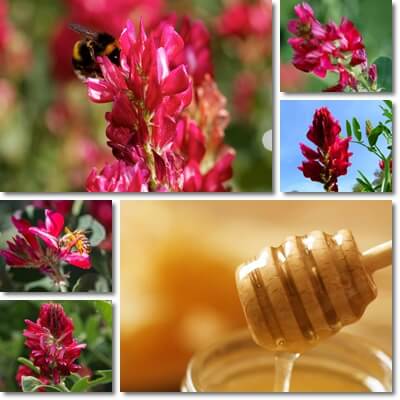Italian sulla honey is a monofloral honey made from the nectar and pollen of Hedysarum coronarium flowers. Hedysarum coronarium is a flowering plant originating in the Mediterranean region and currently cultivated throughout southern Italy, northern Africa and Spain for use as animal feed and for honey production. Eating Italian sulla honey is said to be good for treating a sore throat, cough, colds, some flu symptoms and relieving stomach aches. The honey has antibacterial, anti-acne, antioxidant, soothing and tonic properties.
Other common names for Italian sulla honey include French honeysuckle honey, Italian sainfoin honey, Spanish sainfoin honey, sulla clover honey or miele di sulla, depending on the region or country where it is produced. However, it should not be confused with sainfoin honey or miele di lupinella, produced from the nectar and pollen of Onobrychis viciifolia flowers. While the common names may be similar, you can distinguish the two honey varieties by their color, taste and properties.

Italy is currently the largest producer of the variety and sulla honey holds some of the highest certifications for clean honey production in Italy. Italian sulla honey has been awarded the Traditional Italian Food certificate (PAT) that guarantees a high standard of quality and cleanliness for honey production using traditional methods. The certificate recognizes the honey as an artisanal variety of the highest quality, with a history of over 25 years of clean, responsible, high-standard honey production.
What does Italian sulla (sainfoin, French honeysuckle) honey look like? The variety is a very light, clear yellow, almost white in color. It crystallizes fast after harvest, in a matter of months, and forms fine crystals. Crystallized Italian sulla honey has a duller, even whiter color, like white wax.
What does Italian sulla (sainfoin, French honeysuckle) honey taste and smell like? The variety has a delicate flavor, faint floral smell and a particularly sweet taste with subtle floral undertones. It has a thicker, slightly grainier texture from the beginning, due to crystals forming soon after the honey is harvested. Where is sulla honey produced in Italy? The variety is produced in the pristine highlands of Sicily, Calabria, the Abruzzo and Molise regions in southern Italy and Lucania or Basilicata, also in the south.

Proven health effects
What are the health benefits of Italian sulla honey? Eating sulla honey is said to be good for a variety of minor health issues relating to the digestive, nervous, cardiovascular and immune system and boasts the following properties:
1) Natural antibacterial action. The natural antibacterial properties of Italian sulla honey are a result of its content of hydrogen peroxide, a natural disinfectant, but also low moisture content and low pH (acidity) which actively reduce bacteria numbers and prevent their spread.
2) Good for sore throat and cough. Eating a tablespoon of Italian sulla honey several times a day and postponing eating and drinking anything else for about an hour afterwards is great for a sore throat, helping reduce discomfort and irritation. Because of its low moisture content and texture, the honey forms a protective coating over the throat lining, allowing it to heal. At the same time, it helps reduce bacteria numbers thanks to its antibacterial properties. The specific consistency and other properties of the honey also help calm cough.
3) Helps with gastritis. Like other honey varieties, Italian sulla honey too has been used for gastritis treatment. The honey is taken on an empty stomach in the morning for several days in a row to help calm irritation. It is recommended to avoid drinking or eating anything for at least an hour to let the honey produce its beneficial effects. Because of its thick consistency, it is believed the honey forms a sort of protective layer over the stomach lining, allowing it to heal.
However, it is important to understand that gastritis is a complex condition that requires a strict eating regimen and often also medication from the doctor, and honey, while beneficial to a point, is but an alternative, complementary approach.
4) Natural remedy for uneven skin tone and oily skin. Light-colored honeys like sulla honey or acacia can be an effective natural face mask for uneven skin tone. Just apply the honey on a clean face and let it sit for about 20 minutes, then wash the face with lukewarm water. In my experience, the skin tone is much more even and the face is brighter, more radiant. Moreover, its gentle cleansing effect makes it great for oily skin, reducing excess sebum without drying out the skin.
5) Helps prevent acne breakouts. Thanks to its antibacterial action, Italian sulla honey can help prevent more severe acne breakouts. Moreover, the honey helps unclog pores and has mild exfoliating properties, contributing to smooth skin and a healthier skin. Daily use is recommended for best results and only raw, unprocessed, certified sulla honey should be used.
How fast does Italian sulla honey work on acne and lightening skin tone? It could take as little as one week or as long as several weeks to see visible results. The secret is to be consistent and keep using the honey mask. Also, eating the honey does very little for acne and other skin problems because it’s not actually an anti-acne food, but using it topically does help.
6) Source of vitamins and minerals. Italian sulla honey is a source of vitamins and minerals, containing trace amounts of vitamin C, B vitamins, potassium, calcium and other essential nutrients, all found in trace amounts.
7) Energizing action. In addition to a variety of vitamins and dietary minerals, the honey contains trace amounts of amino acids, pollen, propolis and other nutrients that contribute to its nutritional value and tonic effects. This, along with its natural sugar content, makes it an energizing food.
8) Helps relieve constipation. Italian sulla honey is said to possess mild laxative properties and help relieve constipation naturally. Its properties are believed to be a result of the honey’s content of oligosaccharides, chains of sugars that act as dietary fiber, supporting intestinal motility as well as nourish the good bacteria in our digestive system. However, the effects are mild.
Conclusion
Italian sulla honey is a healthy option for anyone that isn’t allergic to honey or sulla flower pollen. The honey boasts antibacterial, anti-acne, energizing and mildly laxative properties and is a good source of vitamins, minerals and antioxidants such as polyphenols, particularly flavonoids. The best honey is raw, unprocessed and unfiltered because it retains all of its beneficial compounds. Eating the honey raw is preferable to using it for cooking because heat destroys most of its beneficial properties.
